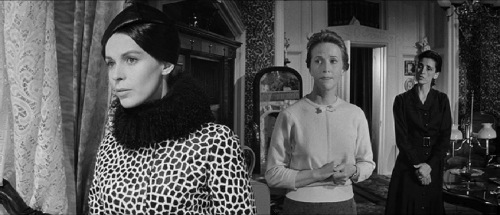The Lesbian Vampire.
Theodora: Is this another one of your crazy ideas?
Eleanor: I’m not crazy!
Theodora: Crazy as a loon! You really expect me to believe that you’re sane and the rest of the world is mad?
Eleanor: Well why not? The world is full of inconsistencies. Full of unnatural beings, nature’s mistakes they call you for instance!
The text above is dialogue from Robert Wise’s film The Haunting (1963) in which Dr. Markway, a researcher into paranormal activity, has assembled a group to investigate the reputed haunting of the gothic New England mansion Hill House. Amongst the group are the clairvoyant Theodora, a bold, outspoken woman who exudes worldly sophistication, and Eleanor, an awkward spinster who’s spent most of her adult life caring for her sick mother. In spite of their differences, Theodora befriends the mousy Eleanor, and there’s even the hint of romantic interest — however unlikely — emanating from Theodora. Director Robert Wise and screenwriter Nelson Gidding conceived of the Theodora character as lesbian, which would be one of the earliest appearances of a queer character in cinematic horror. Of course, the social climate of the early 1960’s meant that references to Theodora’s sexual orientation were all very codified and subtle, but Eleanor’s accusation of “…unnatural beings…” and “nature’s mistakes…” allude not only to Theo’s preference in romantic partners, but they clearly establish homosexuality as an indication of deviance and ‘unnaturalness’.

Claire Bloom stars as Theodora (far left), Julie Harris as Eleanor (centre) and Rosalie Crutchley as the stony and gloriously creepy groundskeeper Mrs. Dudley in Robert Wise’s “The Haunting” (1963).
As was discussed in my earlier post on gender & the slasher film, queerness and the fluidity of gender identity in horror fiction is frequently a sign of mental illness. The cross-dressing serial killer — Norman Bates, for instance — and the homicidal, lovesick lesbian from Aja’s Haute Tension are examples of blurred gender boundaries being symptomatic of mental instability. While the character of Theodora in Wise’s The Haunting is not portrayed as violent nor mentally ill, her lesbianism marks her as ‘unnatural’ as the haunted Hill House in which the drama unfolds. This notion is certainly ironic given that it is the socially-awkward Eleanor, and not Theodora, who stands out as “the one who doesn’t belong” within the group.
This takes us to the third most common female trope in horror fiction: the Lesbian, and specifically the Lesbian Vampire. Why vampire, you ask? Simple. This trope has its roots in Joseph Sheridan le Fanu’s novella Carmilla (1872) about the predatory love of a female vampire for a young woman. Le Fanu’s novella was influential not only on Bram Stoker’s Dracula — which it predated by 25 years — but serves to this day as the source chiefly consulted for the female vampire. (See my post on The Vampiress for more on this topic). The reason for the popularity of the Lesbian Vampire seems fairly straightforward: titillation, pure and simple. Wikipedia sums this up neatly:
This was a way to hint at or titillate with the taboo idea of lesbianism in a fantasy context outside the heavily censored realm of social realism (Weiss 1993). Also, the conventions of the vampire genre — specifically, the mind control exhibited in many such films — allow for a kind of forced seduction of presumably straight women or girls by lesbian vampires.
In the early 1970’s, Britian’s Hammer Studios created the much beloved Karnstein Trilogy, a series of lesbian vampire films very loosely based on Le Fanu’s novella: The Vampire Lovers (1970), Lust for a Vampire (1971) and Twins of Evil (1971). I’ve only seen the first film, which stars the iconic ‘Hammer Girl’ Ingrid Pitt and is quite giggle-worthy. File under ‘guilty pleasure.’
For the most part, the Lesbian Vampire is more softcore than horror, and bears little resemblance to the gender-bending serial killers mentioned earlier. What they do have in common, however, is the demarcation of Otherness — even the racy, breast-biting vampire of Twins of Evil is ultimately portrayed as ‘aberrant’ and ‘deviant.’
In Part IV of this series of posts, I’ll address the Rape-Revenge Girl.


